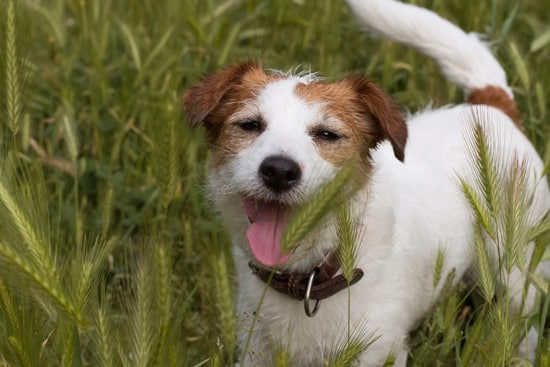Dog Health
The Dangers Of Grass Seeds For Dogs
It may seem the most of innocuous of surfaces, but during the summer months grass can pose a real danger to your dog. Grass seeds can cause serious pain, injury and, in cases, fatal infections by penetrating the skin. Learn how to protect your dog and spot the signs of an embedded seed
They may look beautiful and evoke images of hazy summer days, but once you become a dog owner grass seeds take on a more sinister guise.
Arrow-shaped and with a pointed head, grass seeds are perfectly designed to cling on to fur, penetrate deep into the skin and move around the body. The paws, legs and ears are particularly vulnerable, while it is possible for seeds to embed into the eye and to be inhaled or ingested.
It may seem surprising, but during the summer months grass seeds are responsible for a huge number of veterinary admissions. Any breed can be affected by grass seeds, but Spaniels, with their long ears and dogs with thick, dense coats, are particularly at risk.
Signs of a problem
It can be difficult to spot if your dog is suffering from a problem as the signs of an embedded grass seed – licking the fur, whining and general irritation – could apply to a range of problems. Add to the fact that grass seeds fail to show up on x-rays and it shows how important it is to check your dog after each walk.
Signs to look out for include:
- Paws. Swelling and small bumps, redness and an entry point that is likely to be inflamed and weeping. Your dog is likely to give you a clue by nibbling or licking the affected area. It is really important to be vigilant here as the paws are entry points by which grass seeds can travel up the legs and into the body.
- Ears. Easier to spot as your dog is likely to show visible irritation such as scratching/shaking/rubbing their ears along the floor. They are likely to show distress when the ears are touched, hold their head to one side, cry and shake. If you suspect your dog has a grass seed in their ears you must seek out immediate veterinary attention as the eardrum could rupture, leading to deafness, a loss of balance or even death if the seed travels into the brain.
- Eyes. Swollen, red and inflamed, the eyes may appear watery with your dog visibly irritated and rubbing the area. Grass seeds can enter the eye itself leading to possible blindness or removal of the eye
- Nose. Continuous sneezing, rubbing of the nose and face and possible bloody discharge from the nose. Your dog is likely to show distress and may struggle to breath. Immediate veterinary attention is essential to prevent the grass seed moving into the airways and lungs, which is usually considered life threatening.
- Coat and skin. The awn (bristle) of the grass seed may be visible protruding from the skin. Look out for small red or pus-filled bumps. Again, your dog is likely to give you a clue by nibbling or licking the affected area
In cases where you cannot easily remove a grass seed yourself, for example, when a seed is sticking out of the skin or paws, take your dog to your vet who should be able to extract it. If the seed is deeply embedded, anaesthesia or sedation may be needed to remove the seed fully and to treat any surrounding infection.
Top tip! With the ears being especially vulnerable it is beneficial to get into the habit of cleaning them regularly. It’s important to get your dog used to having their ears handled as part of your grass seed routine, plus regularly cleaning will reduce the risk of infections and costly trips to the vets. The one for clean & fresh ears is a great all-round for ear health.
Prevention
It is incredibly difficult to keep your dog away from grass seeds. Even in urban areas they can be found growing along the side of pavements, which makes it very hard to have a grass seed-free walk.
In general try to keep your dog away from areas with long grass or where you can visibly see grass seeds. Keep hair short around the paws, ears and armpits and maintain a regular grooming routine in the summer months.
Check your dog over after every walk. Run your hands over their body, in between the toes and under the paws feeling and looking for signs of embedded seeds. Check the ears, armpits and hips. If you suspect your dog has a grass seed stuck somewhere, do not wait to see what happens. When a grass seed is embedded it will only move deeper into the skin, ears or eyes, so immediate veterinary attention is vital.
Consider a snood to keep ears (especially Spaniel ears) protected during walks and there are even special boots you can buy to protect paws
5 grass seed essentials
- Keep your dog away from long grass or grass that is visibly in seed
- Check your dog over after every walk between May to September
- A short coat will help prevent grass seeds from clinging to the fur
- Consider a snood to protect the ears
- If you suspect your dog has a grass seed stuck somewhere within their body, seek immediate veterinary attention
